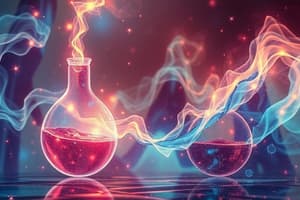Podcast
Questions and Answers
What is chemical equilibrium?
What is chemical equilibrium?
- A state where the reaction does not reach a dynamic balance
- A state where the rates of reactant formation and product decomposition are not equal
- A state where the concentrations of reactants and products do not change with time (correct)
- A state where the concentration of reactants and products changes with time
What does the equilibrium constant measure?
What does the equilibrium constant measure?
- The rate of a reaction at equilibrium
- The rate at which reactants are forming products
- The ratio of the product concentrations to the reactant concentrations at any point during a reaction (correct)
- The thermodynamic driving force of a reaction
According to Le Chatelier's Principle, how does a system at chemical equilibrium respond to a change in concentration, pressure, or temperature?
According to Le Chatelier's Principle, how does a system at chemical equilibrium respond to a change in concentration, pressure, or temperature?
- It does not respond to any changes
- It adjusts its position to minimize the effect of the change (correct)
- It shifts its position to maximize the effect of the change
- It stops the chemical reaction completely
What is the reaction quotient?
What is the reaction quotient?
What is the thermodynamic driving force in a reaction?
What is the thermodynamic driving force in a reaction?
What is the reaction quotient used to determine?
What is the reaction quotient used to determine?
How is the equilibrium position of a reaction defined?
How is the equilibrium position of a reaction defined?
What effect does an increase in the concentration of a reactant have on the equilibrium position?
What effect does an increase in the concentration of a reactant have on the equilibrium position?
What can affect the equilibrium position of a reaction?
What can affect the equilibrium position of a reaction?
What happens to the equilibrium position when there is a decrease in the concentration of a product?
What happens to the equilibrium position when there is a decrease in the concentration of a product?
Flashcards are hidden until you start studying
Study Notes
Chemical Equilibrium
Chemical equilibrium is a state in which a chemical reaction between reactants reaches a dynamic balance, meaning that the rates at which reactants are forming products are equal to the rates at which products are decomposing back into reactants. In this state, the concentrations of reactants and products do not change with time, and the reaction is said to be at equilibrium.
Equilibrium Constant
The equilibrium constant is a measure of the equilibrium position in a reaction, representing the ratio of the product concentrations to the reactant concentrations at equilibrium. It is a dimensionless quantity and is typically calculated from the concentrations of the reactants and products at equilibrium. The equilibrium constant for a reaction is also known as the "thermodynamic driving force".
Le Chatelier's Principle
Le Chatelier's Principle is a concept in chemistry that states that when a system at chemical equilibrium is subjected to a change in concentration, pressure, or temperature, the system will respond by adjusting its position so as to minimize the effect of the change. This principle is based on the law of mass action, which states that the rate of a reaction is proportional to the product of the concentrations of the reactants.
Reaction Quotient
The reaction quotient is a dimensionless quantity that represents the ratio of the product concentrations to the reactant concentrations at any point during a reaction. It is defined as the ratio of the product concentrations raised to their stoichiometric coefficients to the reactant concentrations raised to their stoichiometric coefficients. The reaction quotient is used to determine the direction of a reaction and can be used to calculate the equilibrium constant.
Equilibrium Position
The equilibrium position is the state of a reaction where the concentrations of the reactants and products are such that the reaction occurs at a net zero rate. In other words, the forward reaction and the reverse reaction are occurring at equal rates, and the concentrations of the reactants and products do not change.
Factors Affecting Equilibrium
Several factors can affect the equilibrium position of a reaction, including changes in temperature, pressure, and concentration of reactants and products. An increase in the concentration of a reactant will shift the equilibrium position in the direction that reduces the concentration of that reactant, while a decrease in the concentration of a reactant will shift the equilibrium position in the opposite direction. Similarly, an increase in the concentration of a product will shift the equilibrium position in the direction that reduces the concentration of that product, while a decrease in the concentration of a product will shift the equilibrium position in the opposite direction.
Studying That Suits You
Use AI to generate personalized quizzes and flashcards to suit your learning preferences.




